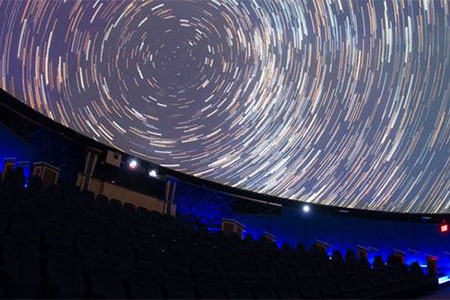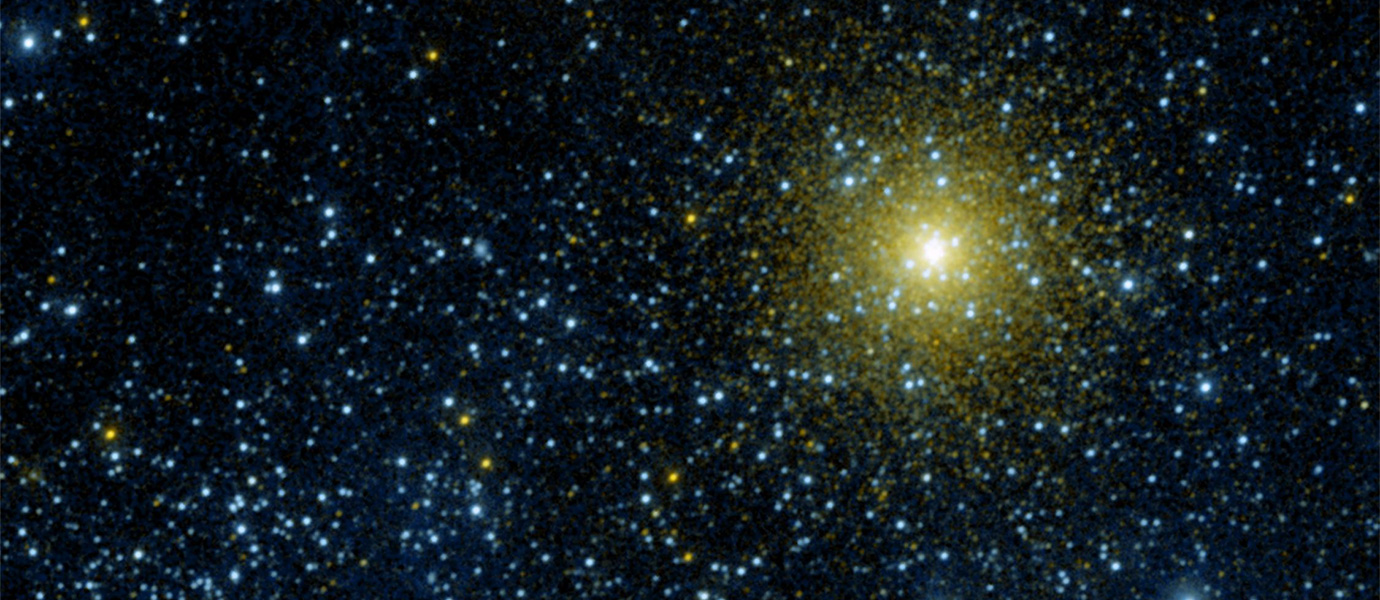
Bishop Planetarium
Students of all ages can travel the galaxy, discovering our solar system through the eyes of a family from another star system. Other shows include a journey from our home planet and the Milky Way galaxy to the edge of the universe, an experience of the life and death of the stars in our night sky, a celebration of the pivotal discoveries that have led to greater knowledge of the structure and history of the universe, and more. Field trip experiences can be booked Tuesday through Friday.
supports classroom learning in:
Science, Technology.
topics covered:
Science, Technology, Planets, Solar System.
contact info
Name: Susan McCarthy, Program Coordinator.
Phone: 941-746-4131 ext. 113
Email: [email protected]
INFO
ABOUT
Bishop Planetarium
The Bishop Planetarium at the South Florida Museum is the region’s premier astronomy education facility, as well as a multimedia theater for films, lectures, live music and digital art performances. The Planetarium’s Digistar 5 dual projection system provides a bright and crisp viewer experience. The system allows for exploration of Earth through the use of 200 continually updated satellite datasets of land, ocean, atmosphere and climate and live Bing and OnTerra views of the entire planet.
contact info
Hrs: Tuesday - Saturday 10Am - 5PM, Sunday 12PM - 5PM.
HELPFUL LESSON PLAN(S)
Prepared by FieldTripDirectory.com
Planetarium Lesson Plan
FUN FACTS
Earth has more exposed water than land. Three quarters of the Earth is covered by water! The earth has one moon.
Venus is the brightest planet in our sky and can sometimes be seen with the naked eye if you know where to look. It is the solar system’s brightest planet — yellow clouds of sulfuric acid reflect the sun’s light.
Jupiter is so big that you could fit all the other planets in the solar system inside it.
Pluto is no longer considered a planet — instead, astronomers call it a dwarf planet or planetoid.
View Lesson Plan>>
Bishop Planetarium
Scouts of all ages can travel the galaxy, discovering our solar system through the eyes of a family from another star system. Other shows include a journey from our home planet and the Milky Way galaxy to the edge of the universe, an experience of the life and death of the stars in our night sky, a celebration of the pivotal discoveries that have led to greater knowledge of the structure and history of the universe, and more.
supports scout badges in:
Science, Technology.
topics covered:
Science, Technology, Planets, Solar System.
contact info
Name: Susan McCarthy, Program Coordinator
Phone: 941-746-4131 ext. 113
Email: [email protected]
INFO
ABOUT
Bishop Planetarium
The Bishop Planetarium at the South Florida Museum is the region’s premier astronomy education facility, as well as a multimedia theater for films, lectures, live music and digital art performances. The Planetarium’s Digistar 5 dual projection system provides a bright and crisp viewer experience. The system allows for exploration of Earth through the use of 200 continually updated satellite datasets of land, ocean, atmosphere and climate and live Bing and OnTerra views of the entire planet.
contact info
Hrs: Tuesday - Saturday 10Am - 5PM, Sunday 12PM - 5PM.
HELPFUL LESSON PLAN(S)
Prepared by FieldTripDirectory.com
Planetarium Lesson Plan
FUN FACTS
Earth has more exposed water than land. Three quarters of the Earth is covered by water! The earth has one moon.
Venus is the brightest planet in our sky and can sometimes be seen with the naked eye if you know where to look. It is the solar system’s brightest planet — yellow clouds of sulfuric acid reflect the sun’s light.
Jupiter is so big that you could fit all the other planets in the solar system inside it.
Pluto is no longer considered a planet — instead, astronomers call it a dwarf planet or planetoid.
View Lesson Plan>>
Bishop Planetarium
Campers of all ages can travel the galaxy, discovering our solar system through the eyes of a family from another star system. Other shows include a journey from our home planet and the Milky Way galaxy to the edge of the universe, an experience of the life and death of the stars in our night sky, a celebration of the pivotal discoveries that have led to greater knowledge of the structure and history of the universe, and more. Field trip experiences can be booked Tuesday through Friday.
topics covered:
Science, Technology, Planets, Solar System.
contact info
Name: Susan McCarthy, Program Coordinator.
Phone: 941-746-4131 ext. 113
Email: [email protected]
INFO
ABOUT
Bishop Planetarium
The Bishop Planetarium at the South Florida Museum is the region’s premier astronomy education facility, as well as a multimedia theater for films, lectures, live music and digital art performances. The Planetarium’s Digistar 5 dual projection system provides a bright and crisp viewer experience. The system allows for exploration of Earth through the use of 200 continually updated satellite datasets of land, ocean, atmosphere and climate and live Bing and OnTerra views of the entire planet.
contact info
Hrs: Tuesday - Saturday 10Am - 5PM, Sunday 12PM - 5PM.
HELPFUL LESSON PLAN(S)
Prepared by FieldTripDirectory.com
Planetarium Lesson Plan
FUN FACTS
Earth has more exposed water than land. Three quarters of the Earth is covered by water! The earth has one moon.
Venus is the brightest planet in our sky and can sometimes be seen with the naked eye if you know where to look. It is the solar system’s brightest planet — yellow clouds of sulfuric acid reflect the sun’s light.
Jupiter is so big that you could fit all the other planets in the solar system inside it.
Pluto is no longer considered a planet — instead, astronomers call it a dwarf planet or planetoid.
View Lesson Plan>>
Bishop Planetarium
Students of all ages can travel the galaxy, discovering our solar system through the eyes of a family from another star system. Other shows include a journey from our home planet and the Milky Way galaxy to the edge of the universe, an experience of the life and death of the stars in our night sky, a celebration of the pivotal discoveries that have led to greater knowledge of the structure and history of the universe, and more. Field trip experiences can be booked Tuesday through Friday. The Bishop Planetarium also offers earth and space science courses for homeschool students.
supports classroom learning in:
Science, Technology.
topics covered:
Science, Technology, Planets, Solar System.
contact info
Name: Susan McCarthy, Program Coordinator
Phone: 941-746-4131 ext. 113
Email: [email protected]
INFO
ABOUT
Bishop Planetarium
The Bishop Planetarium at the South Florida Museum is the region’s premier astronomy education facility, as well as a multimedia theater for films, lectures, live music and digital art performances. The Planetarium’s Digistar 5 dual projection system provides a bright and crisp viewer experience. The system allows for exploration of Earth through the use of 200 continually updated satellite datasets of land, ocean, atmosphere and climate and live Bing and OnTerra views of the entire planet.
contact info
Hrs: Tuesday - Saturday 10Am - 5PM, Sunday 12PM - 5PM.
HELPFUL LESSON PLAN(S)
Prepared by FieldTripDirectory.com
Planetarium Lesson Plan
FUN FACTS
Earth has more exposed water than land. Three quarters of the Earth is covered by water! The earth has one moon.
Venus is the brightest planet in our sky and can sometimes be seen with the naked eye if you know where to look. It is the solar system’s brightest planet — yellow clouds of sulfuric acid reflect the sun’s light.
Jupiter is so big that you could fit all the other planets in the solar system inside it.
Pluto is no longer considered a planet — instead, astronomers call it a dwarf planet or planetoid.
View Lesson Plan>>
